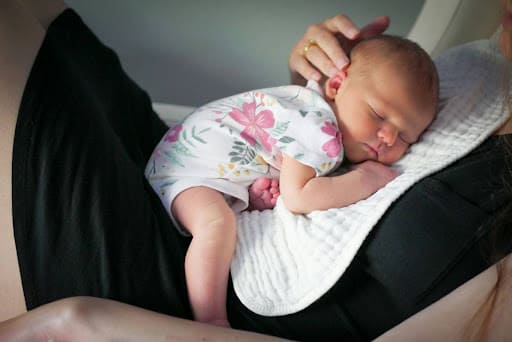The decision to move your baby from your room to their own sleeping space represents a significant milestone for the entire family. While the prospect can feel overwhelming, filled with questions about timing, safety, and whether the change will improve or disrupt sleep, having a structured plan makes the transition smoother for everyone involved.
This comprehensive 30-day guide breaks down the process into manageable weekly phases that respect your baby’s development while supporting your family’s sleep needs.
Understanding the Foundation: Is Your Family Ready?
Before beginning any transition, it’s essential to understand whether this change aligns with your baby’s developmental stage and your family’s circumstances. The American Academy of Pediatrics recommends room-sharing for at least six months, ideally up to one year, to reduce SIDS risk.
Most families find the optimal transition window falls between six and nine months when babies are developmentally ready for more independence.
Many parents wonder do babies sleep better in their own room, and research suggests that after the recommended room-sharing period, independent sleeping spaces can benefit both babies and parents.
Babies often achieve longer, more consolidated sleep stretches without parental movements and sounds disturbing them, while parents enjoy improved sleep quality and privacy. However, timing this transition appropriately and implementing it gradually dramatically increases success rates.
Signs your family might be ready include your baby consistently sleeping through most of the night, outgrowing their bassinet, or room-sharing beginning to disrupt everyone’s sleep.
If your baby still wakes frequently for feeds or comfort, you might want to address those patterns first before adding the complexity of a room change. Readiness isn’t just about the baby; parents must also feel emotionally prepared for this separation.
Pre-Transition Preparation: Setting Up for Success
Before Week 1 begins, invest time in creating an optimal sleep environment in your baby’s new room. The space should be completely dark using blackout curtains or shades, as even small amounts of light can disrupt infant sleep. Temperature matters significantly to maintain the room between 68-72°F (20-22°C) for optimal comfort and safety.
Safety checks are non-negotiable before any transition begins. Ensure the crib meets current safety standards with a firm, flat mattress and fitted sheet only, no blankets, pillows, bumpers, or stuffed animals until at least 12 months. Check that no cords, blind strings, or potential hazards exist within reach of the crib, and ensure smoke detectors and carbon monoxide detectors function properly.
Consider investing in a reliable video monitor that provides clear nighttime viewing and two-way audio. This technology allows you to check on your baby without entering the room and potentially disturbing them. White noise machines can help mask household sounds and create consistent audio environments that promote better sleep throughout the night.
Week 1: Introduction and Familiarization (Days 1-7)
The first week focuses entirely on helping your baby become comfortable in their new room during awake times. Spend 20-30 minutes daily playing in the new room, reading books, doing diaper changes, and creating positive associations with the space. Make the room feel welcoming and familiar rather than suddenly appearing as an unfamiliar nighttime location.
Introduce daytime naps in the new room toward the end of Week 1, starting with just one nap daily. Choose the nap your baby typically handles best, often the mid-morning or early afternoon nap. If they resist or struggle, don’t force it; simply try again the next day while maintaining your usual nighttime routine in your room.
Maintain all existing bedtime routines exactly as they’ve been, changing nothing about nighttime sleep during Week 1. This consistency provides security while your baby adjusts to the new daytime environment. Documenting your baby’s responses in a simple journal, noting mood, nap success, and any concerns, helps you track progress and identify patterns.
Week 2: Expanding Daytime Presence (Days 8-14)

During Week 2, gradually increase the number of naps taken in the new room until all daytime sleep occurs there. This repetition without the added pressure of nighttime separation helps babies internalize that this space is safe for sleeping. Continue your regular nighttime routine and overnight sleep in your room.
Establish a consistent pre-nap routine that mirrors your bedtime routine but in abbreviated form. This might include a diaper change, darkening the room, turning on white noise, a brief cuddle, and placing your baby in the crib drowsy but awake. Consistency signals to your baby that sleep time is approaching, regardless of which sleep session it is.
If naps become more challenging this week, resist the urge to abandon the plan. Temporary disruptions are normal as babies adjust to changes. Maintain your calm, confident approach while offering reassurance, but avoid creating new sleep associations like extended rocking or feeding to sleep that will later need to be addressed separately.
Week 3: The Gradual Nighttime Transition (Days 15-21)
Week 3 introduces the most significant change, beginning nighttime sleep in the new room. Start with the first half of the night only, planning to bring your baby back to your room for the second half. This gradual approach reduces anxiety for both baby and parents while building confidence in the new arrangement.
Maintain your established bedtime routine, but perform it entirely in the new room. Consistency in routine provides comfort even as the location changes. After completing your routine, place your baby in their crib drowsy but awake, then leave the room confidently without lingering or appearing anxious.
Decide in advance on your response plan if your baby cries or protests. Whether you choose to check periodically, use gradual retreat, or another gentle sleep training method, consistency matters more than the specific approach chosen. Around 2-3 AM (or after the first 4-5 hour stretch), bring your baby back to your room for the remainder of the night, maintaining this pattern throughout Week 3.
Week 4: Full Transition and Consolidation (Days 22-30)
Week 4 focuses on completing the transition to full nights in the new room. Your baby now stays in their own room for the entire night, with you responding to wakings as needed but keeping all interactions in their space. This consistency helps cement new sleep patterns and spatial associations.
Expect some regression during the first few nights of full transition. Babies often test boundaries or express discomfort with changes. Maintain your chosen response strategy consistently, resisting the urge to bring them back to your room unless there are legitimate health or safety concerns. Temporary setbacks don’t mean failure; they’re normal parts of adjustment.
By the end of Week 4, many babies have fully adjusted to their new sleeping arrangement. Some may still wake occasionally, but these wakings typically decrease as babies learn to self-settle in their new environment. Parents often report improved sleep quality for the entire family by this point, though individual experiences vary.
Troubleshooting Common Challenges

Increased night wakings during transition are the most common challenge parents face. If wakings exceed your baby’s previous pattern and persist beyond a few nights, ensure all basic needs are met appropriate room temperature, comfortable clothing, and no underlying illness. Sometimes slowing the transition pace helps; there’s no shame in extending any week’s phase if needed.
Bedtime protests can intensify during transitions as babies test new boundaries. Maintain calm consistency rather than rushing in immediately, but don’t let your baby cry indefinitely. Find your family’s comfort level. Gradual retreat methods, where you stay in the room but progressively move farther from the crib, can help anxious babies adjust more comfortably.
Parental anxiety often surpasses the baby’s actual distress during transitions. Many parents find their worry disrupts their own sleep more than their baby’s adjustment disrupts theirs. Using a reliable monitor can help reduce anxiety while avoiding the urge to check constantly, which can actually disturb sleeping babies.
Age-Specific Considerations
For babies 6-9 months old, the transition typically proceeds smoothly as they’re developmentally ready for independence but haven’t yet developed strong protest behaviors. This age group often adapts within 2-3 weeks with consistent implementation. Separation anxiety hasn’t fully developed, making physical separation easier.
Babies 9-12 months may experience stronger separation anxiety, requiring extra patience and reassurance. Consider adding a comfort item like a small lovey (if age-appropriate) or extending Week 3’s gradual approach. These babies benefit from extra daytime connection and reassurance that parents will always return.
Toddlers over 12 months bring different challenges, including stronger wills and the ability to climb out of cribs. The 30-day plan still works but may require adaptations like visual schedules, reward charts, or toddler-specific sleep training approaches. Their increased cognitive abilities mean you can explain changes in simple terms, helping them understand what’s happening.
Creating Long-Term Sleep Success

Once the transition is complete, maintain consistent sleep schedules, routines, and environments to reinforce new patterns. Avoid introducing new sleep associations that might become problematic later, such as staying in the room until your child falls asleep. The independence developed during this transition benefits your child’s sleep skills long-term.
Room transitions inevitably face disruptions from travel, illness, or life changes. When disruptions occur, return to your established routine as quickly as possible rather than abandoning progress made. Temporary co-sleeping during illness doesn’t erase weeks of transition work if you promptly return to independent sleeping once recovered.
Remember that every baby and family is unique. This 30-day plan provides a framework, not rigid rules. Some families complete transitions faster, while others need more time. Adjust the pace based on your baby’s responses and your family’s needs without guilt or comparison to others.
When to Seek Professional Help
If, after completing the 30-day plan, your baby still struggles significantly with independent sleeping, or if night wakings increase dramatically and persistently, consider consulting a pediatric sleep specialist.
Professional guidance can identify underlying issues like sleep associations, scheduling problems, or medical concerns affecting sleep. Sleep consultants provide personalized strategies tailored to your family’s specific situation and parenting philosophy.
Red flags warranting immediate professional consultation include dramatic changes in breathing patterns during sleep, excessive sweating, or other concerning physical symptoms. Trust your instincts if something feels wrong beyond typical adjustment challenges; seek professional evaluation. Sleep problems sometimes indicate underlying medical issues requiring attention.
Conclusion
Transitioning your baby to their own room represents a significant milestone that benefits the entire family when approached thoughtfully and gradually. This 30-day plan provides structure while allowing flexibility to adapt to your baby’s unique needs and temperament. The gradual, week-by-week approach respects both your baby’s developmental readiness and your own emotional adjustment to this separation.
Success isn’t measured by perfection but by progress. Some babies adapt quickly, while others need more time and patience. The investment in creating healthy, independent sleep habits pays dividends for years as your child develops self-soothing skills and sleep confidence.
Trust yourself, remain consistent, and remember that temporary challenges during transition don’t predict long-term outcomes.
Moving your baby to their own room ultimately supports their growing independence while giving parents the rest and privacy they need to function optimally.
With patience, consistency, and this structured approach, most families successfully navigate this transition and enjoy improved sleep quality for everyone involved.





Be First to Comment